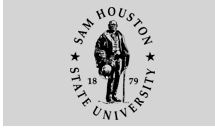Shakespeare Identity Controversy Comes to SHSU
Isn't it odd that no one knows anything about Shakespeare's
daily life: who hung out with the famous Will Shakespeare at
the hottest party, or who spotted him on a ship headed to Italy,
the setting for so many of his great plays?
Ron Song Destro, assistant professor of theatre, will share
his research on the matter of the real Shakespeare on Tuesday,
February 21 at 7 p.m. at the Mainstage theater.
"I've
been studying this pretty much nonstop for the last seven years," said
Destro.
He has presented
his case at Harvard and the University of Bridgeport, among
others, and he thinks the man known as Shaksper (one of the original
spellings) is the very fortunate beneficiary of a case of mistaken
identity.
He began studying
what he calls the "primary sources:" things that were
said and written about Shakespeare only in his own time.
"Many
(secondary sources) are disreputable," he said. "They
say he probably did this, or he may have done that. They're not
fact."
He agrees with
writers like Mark Twain and Ralph Waldo Emerson that Shakespeare's
country lifestyle was an unlikely source for the perspective
of his plays.
Emerson thought that Shakespeare's writing often has a "nobleman's
perspective." His characters are all kings, queens and princes,
and the rare country or lower class person is often portrayed
as a clown.
Further evidence, Destro said, is found in the knowledge Shakespeare
displays of medicine, astronomy, law, the Greek language, and
Greek mythology. This is an unlikely education for a man who
was a grain dealer, said Destro.
"When he died, there was no mention of books or manuscripts
in his will. Back then, if you had them, it would be common to
put them in a will."
Shakespeare also had two daughters who were barely literate.
It doesn't seem possible that a literary genius would let his
children grow up without a passion for books.
So how could the misconception have occurred?
Destro explained that writing was not an honorable hobby or
profession in Shakespeare's time. Getting involved in theater
was especially improper.
"It would be like a congressman writing a porno today," he
said.
But sometimes, noblemen would use a pseudonym to publish their
work. This would protect their anonymity, although their identities
were often revealed after they died.
The first Shakespeare poem, Venus and Adonis , was
published under the name Will Shake-spear. Names were not commonly
hyphenated at that time, Destro said, and this was clearly a
pun; "I will shake a spear."
So who was the real Shakespeare?
The latest theory began when a London schoolteacher decided
to start from scratch.
"He pretended that we didn't know who Shakespeare was," said
Destro. "He made a list of all the qualities that Shakespeare
had as a writer, and the things about his personality that were
evident from his writing."
He looked at the first poem, Venus and Adonis , and
worked from the assumption that this very mature work had to
come from an experienced writer. Someone who had quit writing
under his real name at the same time Will Shake-spear turned
up.
One of the more accomplished writers of that time, the 17th
Earl of Oxford, Edward De Vere, was known for his beautiful verse.
He also had family members who were accomplished writers, and,
as a ward of the royal court, one of the most extensive educations
of the time.
De Vere graduated from Cambridge at 14. He continued with his
schooling to receive a Master of Arts at 16 and then studied
law at the prestigious Gray's Inn. He owned several books that
would have the information Shakespeare used in his writing.
De Vere's poetic style was possibly unique for Elizabethan times.
The Shakespeare Oxford Society states that Venus and Adonis' six
line pentameter stanzas also occur in de Vere's poetry, but
almost nowhere else. As further evidence, he refers to the style
as "first
heir of my invention."
This line is actually in the dedication. It reads, "...if
the first heir of my invention prove deformed, I shall be sorry
it had so noble a god-father."
It may actually refer to the entire poem, and not the pentameter
style.
Another interesting point, according to the Luminarium.org web
site, is that De Vere used many different styles in his poetry: " 11
different metrical and stanzaic forms in the two dozen poems,
including fourteener couplets, the English sonnet, tetrameters,
and trimeters."
Luminarium is a web site dedicated to medieval, Renaissance,
and 17th century literature.
Destro says De Vere is the best candidate for the real
Shakespeare, and he looks forward to sharing his findings and
participating in the discussion next Tuesday.
—END—
SHSU Media Contact: Kelly Jakubowski
Feb. 14, 2006
Please send comments, corrections, news tips to Today@Sam.edu.
|


